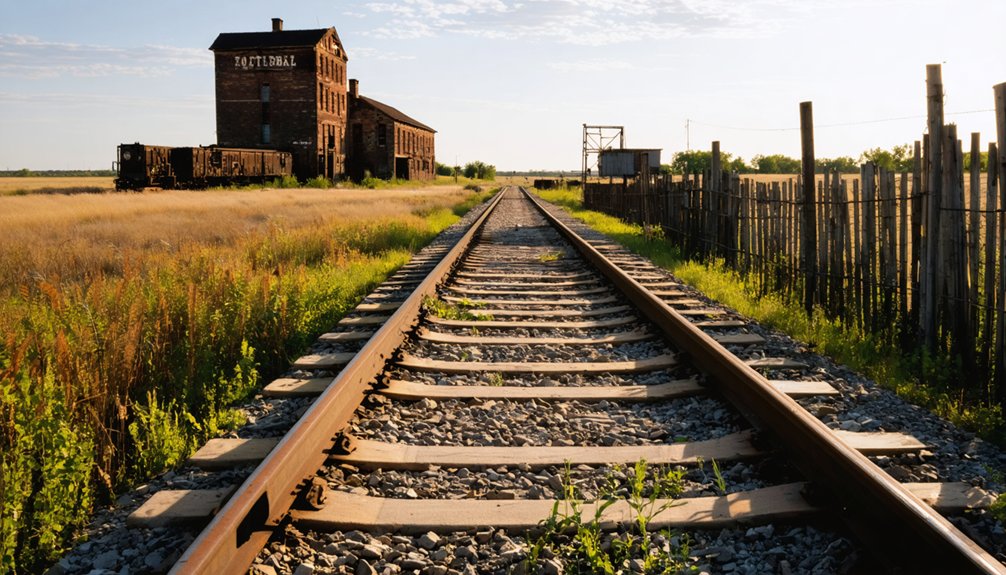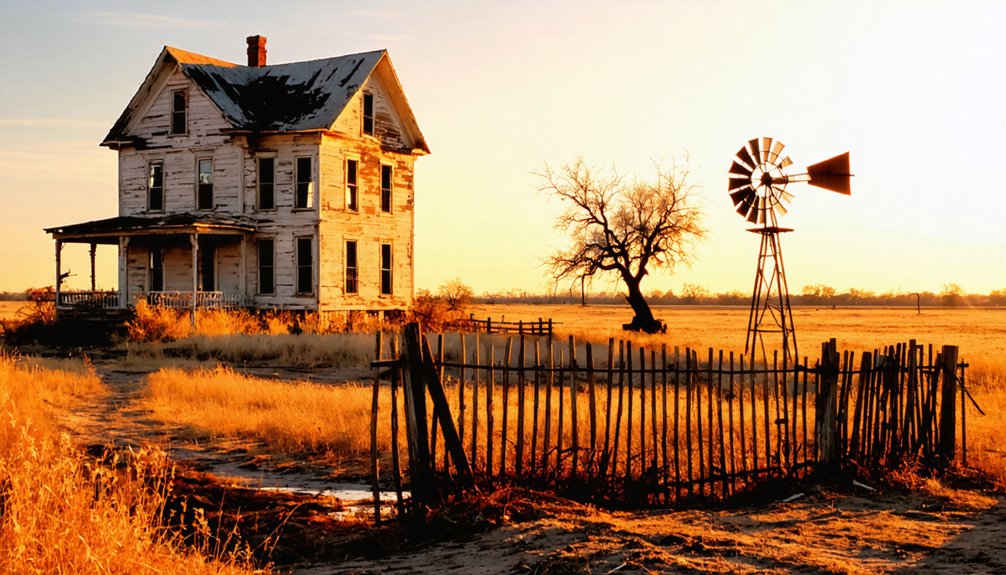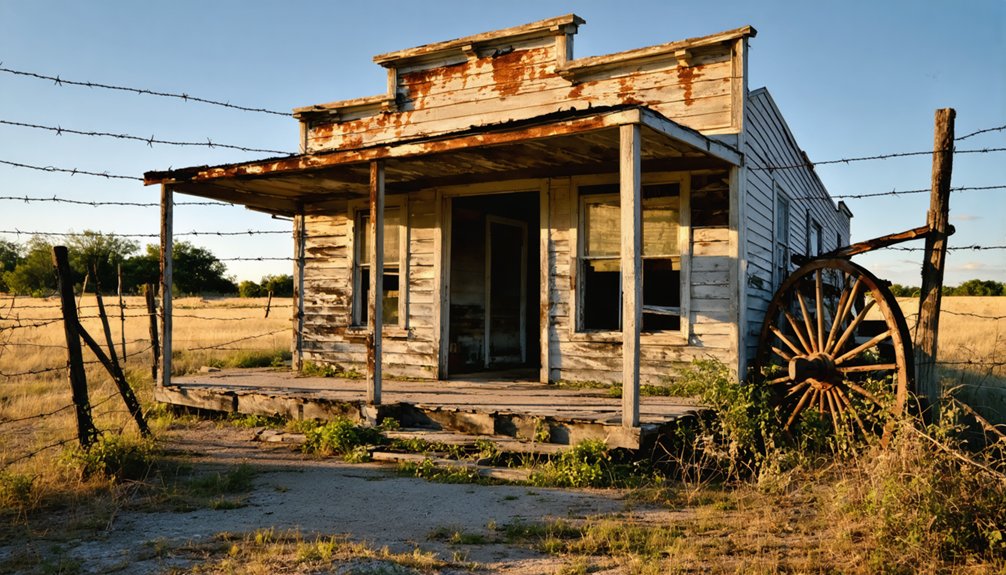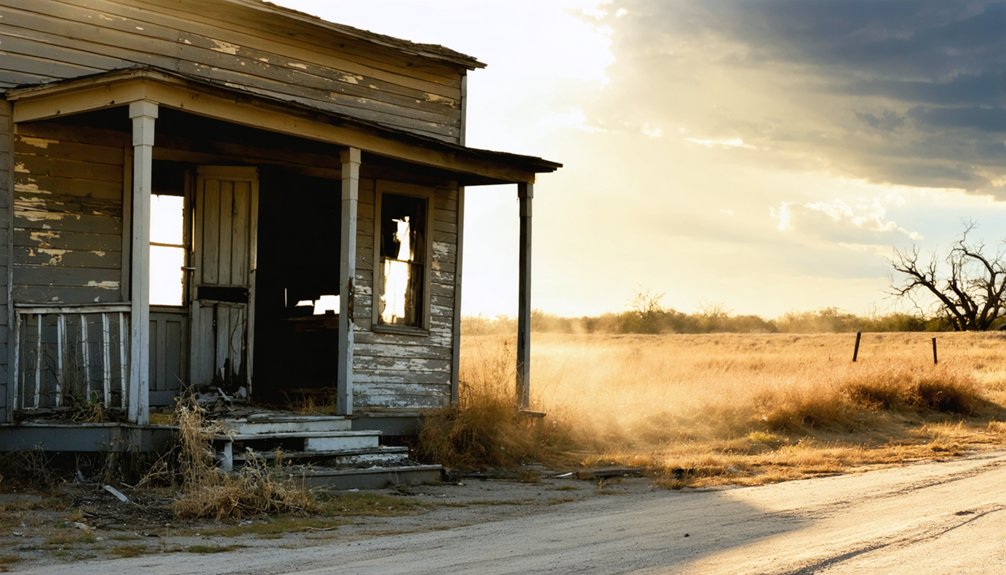You’ll find Carter, Texas, established in 1877 in Brazos County, as a ghost town that once thrived during the post-Civil War era. The settlement grew around a flour mill, church, and school, reaching about 80 residents at its peak. The Houston East and West Texas Railway’s Y-shaped track system helped Carter prosper until the early 1900s, when the boll weevil devastated local cotton crops. Today, the old church building and granite markers tell tales of this vanished community’s fascinating past.
Key Takeaways
- Founded in 1877 in Brazos County, Carter was a post-Civil War settlement that grew around a railroad, flour mill, and church.
- The town peaked at 80 residents, thriving on cotton farming until the boll weevil infestation in the early 1900s devastated crops.
- The Houston East and West Texas Railway’s decline after 1907 led to Carter’s downfall, with businesses and services closing permanently.
- Only the old church building remains as the primary surviving landmark, with granite markers commemorating the settlement’s history.
- Visitors can explore the church ruins, historical markers, and settlement remnants, with ghost stories adding to the site’s mystique.
The Birth of a Post-Civil War Settlement
While many Texas communities emerged during Reconstruction, Carter’s establishment in 1877 marked a distinctive post-Civil War settlement in Brazos County.
You’ll find its roots in the shift of wilderness into cultivated land, as post-war migration brought new settlers seeking opportunities in Texas’s changing landscape.
The settlement’s foundation rests on land originally granted to Richard Carter in 1831 under Stephen F. Austin’s colony.
Carter families played a crucial role in the area’s development, with their influence reflected in the community’s name and early infrastructure. Richard Carter served in the militia during the War of 1812 before moving to Texas. The area was once described as being infested with bears and other wild animals before settlement transformed the region.
The establishment of a post office in 1877 signaled the settlement’s growth, serving as an essential communication hub until 1881.
The community attracted freedmen and other newcomers, contributing to the area’s agricultural development and changing social dynamics during Reconstruction.
Life in Early Carter (1866-1900)
You’d find daily life in Carter centered around its flour mill, church, and local school, where settlers balanced agricultural work with community gatherings.
The church, which still stands today with its adjacent meeting pavilion, served as both a spiritual center and social hub where families would congregate for various events. The site now represents local history preservation through community support and donations.
Your children would have attended the local schoolhouse while you might’ve visited the trading post, cotton gin, or blacksmith shop – all essential structures that supported the town’s roughly 80 residents. The town’s location off Highway 51 made it accessible for trading with neighboring communities.
Daily Pioneer Activities
Life in Carter from 1866 to 1900 revolved around essential economic activities that sustained the frontier settlement. You’d find pioneer routines centered on the flour mill and cotton gin, where farmers brought their harvests for processing.
Daily agriculture demanded intense manual labor, from working the fields to maintaining livestock. Your survival depended on a mix of farming, hunting, and trading. You’d grow vegetables for personal use while raising grain and cotton as cash crops. Settlers faced constant threats from Indian raids during these early years. Like many communities of that era, the town established a post office service to maintain vital connections with other settlements.
The blacksmith’s hammering would echo through town as he crafted tools for your agricultural needs. When winter approached, you’d preserve food and stockpile supplies. You’d rely on neighbors during planting and harvest, forming tight-knit bonds through shared labor.
The church served as your community center, where you’d gather for both worship and social events.
Church and School Impact
Since Carter’s founding in 1866, the church and schoolhouse formed the bedrock of community life, with Our Savior’s Lutheran Church established in 1878 serving as both a spiritual sanctuary and social hub.
Like former slave settlements, Sweet Home and Stiles, Carter was a testament to resilient pioneer communities carving out new opportunities in Texas. The church community fostered resilience through challenging times, while the educational legacy of Carter’s one-room schoolhouse equipped pioneer children with essential skills for frontier life. Similar to Whitt Seminary’s diverse curriculum, the school provided comprehensive instruction in subjects ranging from basic arithmetic to advanced studies.
- You’d find the church’s covered meeting area bustling with town gatherings, picnics, and civic meetings that strengthened community bonds.
- You could witness children of all ages learning together in the schoolhouse, which doubled as a venue for elections and public assemblies.
- You’d see how these institutions provided stability and structure, helping settlers maintain their values despite Indian raids and local conflicts.
The eventual closure of these cornerstones in the early 1900s marked Carter’s decline into a ghost town.
Agricultural Backbone and Economic Growth
When Carter, Texas emerged in 1866, agriculture formed the bedrock of its economic prosperity.
You’d find cotton fields stretching across the landscape, with a local gin processing the harvests. The town’s flour mill transformed locally grown grains, while blacksmith shops kept essential farming equipment running.
But you couldn’t escape the harsh realities of agricultural dependence. Without proper crop rotation, the soil gradually lost its vitality. Like many abandoned Texas towns, Carter’s story reflects the changing economic tides that swept through the state.
When the dreaded boll weevil struck in the early 1900s, it devastated cotton crops throughout Texas, causing estimated losses of 700,000 cotton bales and millions in damages. These challenges, combined with plummeting cotton prices, struck at Carter’s economic sustainability.
The boll weevil’s arrival spelled doom for cotton farming, crushing Carter’s economy alongside tumbling crop prices.
The town’s singular focus on agriculture left it vulnerable – as farming declined, so did Carter’s population of 80 residents, marking the beginning of its transformation into a ghost town.
Community Landmarks and Infrastructure
Though most of Carter’s original structures have vanished into history, the old church building stands as the town’s primary surviving landmark, anchoring what was once a vibrant community hub.
Along a dirt road near the church, you’ll find granite markers commemorating frontier-era events, including an 1878 gun battle and the legendary “Seven Rugged Riders.” The town’s infrastructure once supported strong community cohesion through various gathering spaces.
- The church, steeped in local folklore, remains haunted by tales of an old minister’s apparition
- A tree-lined canopy walkway beside the church hints at past pedestrian pathways
- Historical markers serve as silent witnesses to Carter’s frontier struggles and triumphs
The town’s commercial heart – including its flour mill, cotton gin, and blacksmith shop – has disappeared completely, leaving only memories of its self-sufficient past.
Transportation Hub and Railway Impact

As railroad pioneers William Thomas and Ernest A. Carter established the Moscow, Camden and San Augustine Railroad Company in 1898, they forever changed the transportation evolution of the region.
You’ll find their $250,000 venture initially connected Moscow to Camden with a seven-mile line, linking to the Houston East and West Texas Railway.
The railway’s significance extended beyond mere tracks – it became the lifeline of Carter’s economic survival.
You’d have seen the bustling Y-shaped track system enabling locomotive turns, while the tram lines efficiently moved timber from remote forests to sawmills.
This transportation network helped W.T. Carter and Brother Lumber Company centralize their operations and accelerate timber extraction.
However, when rail service eventually declined, Carter’s fate was sealed, leaving only the abandoned station as proof of its once-thriving railway heritage.
The Slow Decline of a Texas Town
You’ll find that Carter’s decline became most apparent after 1907, when essential businesses like the flour mill and cotton gin began shutting down.
The town’s population, which had reached about 80 residents during its peak in the late 19th century, steadily dwindled as families sought opportunities elsewhere.
Economic Activities Fade Away
While Carter, Texas once thrived as a bustling lumber town centered around the Carter-Kelly Lumber Company, its economic foundation began crumbling in January 1935 when a catastrophic fire destroyed the town’s sawmill.
The economic shifts hit hard as you would’ve witnessed:
- Your local stores, hotels, church, and school shuttered their doors forever.
- Your town’s lifeblood – the railway depot – fell silent as trade dried up.
- Your community scrip became worthless as the company commissary closed.
The industrial decline spread beyond lumber – nearby ranching operations struggled, and agricultural ventures waned.
The once-shared community economy fractured into private ownership, with land selling for as little as $1 per acre.
Population Exodus Accelerates
The economic downturn that ravaged Carter’s commercial hub sparked a surprising twist in the town’s demographic story.
Despite popular population myths about small Texas towns dying out, Carter’s numbers tell a different tale of community resilience.
You’ll find Carter’s population actually growing from 1,642 in 2023 to a projected 2,170 by 2025.
While the town faces its share of challenges, including a 13.8% poverty rate and an aging male population averaging 44.2 years, it’s hardly becoming a ghost town.
The community maintains a steady density of 255.5 people per square mile across its 6.4 square miles, with a diverse makeup that’s mainly White but includes growing Hispanic representation.
Rather than exodus, you’re witnessing transformation as Carter adapts to changing demographics and economic pressures.
Infrastructure Gradually Crumbles
Despite Carter’s growing population figures, its infrastructure tells a sobering story of gradual decay.
You’ll see the stark signs of infrastructure neglect everywhere you look – from crumbling roads to failing utility systems that once served a thriving community. The town’s essential services have deteriorated as tax revenues dwindled, leaving you with unreliable water supply and spotty emergency response coverage.
- Abandoned buildings stand as silent witnesses to community decay, their structures weakening with each passing season.
- Streets that once bustled with activity now sprout weeds through cracked pavement.
- Water mains leak precious resources into Texas soil while aging power lines struggle to maintain consistent service.
The harsh reality is that Carter’s infrastructure collapse mirrors many Texas ghost towns, where rapid development gave way to abandonment and disrepair.
Notable Structures That Once Stood
During Carter’s heyday in the late 1800s, several essential structures formed the backbone of this frontier settlement. You’d have found a bustling flour mill near Clear Fork Creek and a cotton gin processing local harvests, though these historic remnants have long since disappeared.
The town’s commercial district featured a general store and blacksmith shop, while a post office branch opened in 1888, cementing Carter’s place on the map.
The old church building stands as one of the few surviving structures, complete with its covered pavilion and canopied walkway.
The town’s common school educated local children, though like many vanished enterprises, no trace of it remains today.
Granite markers now tell tales of Carter’s dramatic past, including an 1878 gun battle between cattlemen and conflicts with Comanche warriors.
What Remains Today

- The church has become a magnet for Carter legends and paranormal investigations, drawing those seeking connections to frontier-era spirits.
- Historic markers dot the landscape where mills, shops, and schools once stood, preserving memories of a vanished community.
- A canopy of trees creates shadowy pathways through the grounds, adding to the site’s haunting atmosphere that beckons ghost hunters.
- The old church building stands as a symbol of pioneer determination, having served multiple roles in the community’s development.
- Granite markers throughout the area chronicle the intense struggles of frontier defense against Native American raids.
- Memorial sites preserve the memory of families like the Tacketts, who demonstrated extraordinary courage in protecting their homesteads.
- Stand in the shadow of the haunting old church building, where tales of ghostly encounters with an ancient minister still circulate.
- Walk among the granite markers that tell stories of frontier conflicts, including the famous 1878 gun battle.
- Experience the eerie calm of a once-bustling settlement where historical preservation efforts maintain the last vestiges of Texas frontier life.
- https://www.tshaonline.org/handbook/entries/carter-tx-stephens-county
- https://www.ghostsandgetaways.com/ghost-towns
- https://en.wikipedia.org/wiki/List_of_ghost_towns_in_Texas
- https://occult-world.com/carter-ghost-town/
- https://www.ghosttowns.com/states/tx/carter.html
- https://www.tshaonline.org/handbook/entries/carter-tx-parker-county
- https://www.texasescapes.com/TexasGhostTowns/Carter-Texas.htm
- https://www.texasescapes.com/TOWNS/Texas_ghost_towns.htm
- https://www.tshaonline.org/handbook/entries/carter-richard
- https://theclio.com/entry/58457
Legacy in Parker County History
You’ll find Carter’s most enduring impact on Parker County in its role as an early agricultural settlement hub, complete with essential frontier infrastructure like a flour mill and cotton gin.
As one of the county’s pioneering communities established in 1866, Carter helped establish settlement patterns that would define the region’s development through the late 19th century.
The town’s strategic placement and self-sufficient nature, with its blacksmith shop, general store, school, and church, provided a template for other Parker County settlements to follow.
Historical Community Impact
Though Carter no longer exists as a functioning town, its historical impact on Parker County remains significant through preserved landmarks and enduring stories of frontier life.
You’ll find a reflection of community resilience in the remaining structures and historical markers that tell the tale of settlers who faced tremendous challenges between 1854 and 1874.
These physical reminders help you understand the complex relationship between settlers and Native Americans during Texas’s frontier period.
Agricultural Settlement Patterns
Following ancient Indian-established trails, the earliest European settlers in Parker County began carving out their agricultural communities along the Brazos River in the late 1840s, marking a significant shift in the region’s land use patterns.
Settlement dynamics quickly evolved as pioneers claimed land grants, with properties like the 1,280-acre Carter tract shaping local development.
You’ll find that by the late 1850s, these determined settlers had cultivated 10,000 acres and amassed over 10,000 head of cattle.
Agricultural innovations emerged through necessity, as farmers adapted their practices to the region’s climate extremes. They’d established trading posts, flour mills, and blacksmith shops by 1860, creating a resilient barter economy where livestock products often served as currency.
Despite challenges from Indian raids and harsh frontier conditions, this agricultural foundation transformed Parker County into a thriving farming and ranching region.
Visiting the Ghost Town Site

Planning a trip to Carter requires careful timing and preparation, as this remote ghost town site offers minimal amenities but rich historical significance.
You’ll find the site off Texas Highway 51, approximately 10 miles north of Weatherford, accessible via dirt roads that are best traveled during dry conditions.
For the best experience, visit during spring or fall to avoid extreme temperatures.
Remember to bring water, wear sturdy shoes, and prepare for limited cell service in this isolated location.
Frequently Asked Questions
What Were the Common Causes of Death Among Carter’s Early Settlers?
You’d face deadly disease outbreaks, injuries from wildlife encounters, drowning in flooded creeks, gunshot accidents, and frontier hardships like exposure to extreme weather, malnutrition, and violence from bandits or conflicts.
Did Any Famous Outlaws or Notable Historical Figures Visit Carter?
Despite outlaw legends across Texas, you won’t find records of famous outlaws visiting Carter. Only one documented 1878 gunfight between cattlemen and local “Seven Rugged Riders” marks the town’s historical visits.
Were There Any Significant Native American Interactions With Carter’s Community?
You’ll find Carter’s community faced violent raids resulting in deaths and captives, rather than peaceful Native American treaties or cultural exchanges. The attacks included the devastating raid on Carter Trading Post.
What Natural Disasters or Extreme Weather Events Affected Carter’s Development?
You’ll find Clear Fork Creek exposed the town to flood consequences, while drought impact stressed local agriculture. Hot summers and cold winters challenged Carter’s mills, though no single catastrophic weather event is documented.
Did Carter Have Any Unique Local Traditions or Annual Celebrations?
Time may tell many tales, but you won’t find records of unique Carter traditions or annual celebrations. The church hosted community gatherings, but no documented festivals survived from this frontier town’s history.



